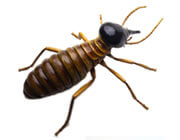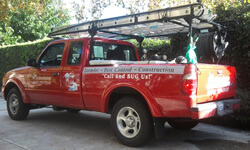Termites

Although many people think termites have only negative impacts, in nature they make many positive contributions to the world’s ecosystems. Their greatest contribution is the role they play in recycling wood and plant material. Their tunneling efforts also help to ensure that soils are porous, contain nutrients, and are healthy enough to support plant growth.
Termites become a problem when they consume structural lumber. Termite pests in California include drywood, dampwood, and subterranean species. These pests cause serious damage to wooden structures and posts and may also attack stored food, books, and household furniture.
Identification
Termites are sometimes confused with winged forms of ants, which also leave their underground nests in large numbers to establish new colonies and swarm in a manner similar to that of reproductive stages of termites. However, ants and termites can be distinguished by checking three features: antennae, wings, and waist.
Termites are social and can form large nests or colonies, consisting of very different looking individuals (castes). Physically the largest individual is the queen. Her function is to lay eggs, sometimes thousands in a single day. A king is always by her side. Other individuals have large heads with powerful jaws, or a bulb-like head that squirts liquid. These individuals are called soldiers. But the largest group of termites in a colony is the workers. They toil long hours tending the queen, building the nest, or gathering food. While other species of social insects have workers, termites are unique among insects in that workers can be male or female. Surprisingly, termites can be long-lived: queens and kings can live for decades while individual workers can survive for several years.
Signs of termite infestation include swarming of winged forms in fall and spring and evidence of tunneling in wood. Darkening or blistering of wooden structural members is another indication of an infestation; wood in damaged areas is typically thin and easily punctured with a knife or screwdriver.
Management
Successful termite management requires many special skills, including a working knowledge of building construction. An understanding of termite biology and identification helps detect problems and understand methods of control. In most cases it is advisable to hire a professional pest control company to carry out the inspection and control program.
Management techniques vary depending on the species causing an infestation. Multiple colonies of the same species of termite or more than one species of termite can infest a building. Any of these variables will influence your control approach. Subterranean, and less frequently, dampwood termites can have nests at or near ground level, so control methods for these can be similar. However, drywood termites nest above ground, therefore the approach for eliminating them is unique.
Use an integrated program to manage termites. Combine methods such as modifying habitats, excluding termites from the building by physical and chemical means, and using mechanical and chemical methods to destroy existing colonies.
Our page on termite control in Orange County and Los Angeles County tells you about the approaches we use to control them.
Fat Cat Exterminators is ready to provide a comprehensive program specialized to fit your needs. Please contact us today to schedule an appointment.
Thank you for considering Fat Cat Exterminators as you search for a pest control partner.





